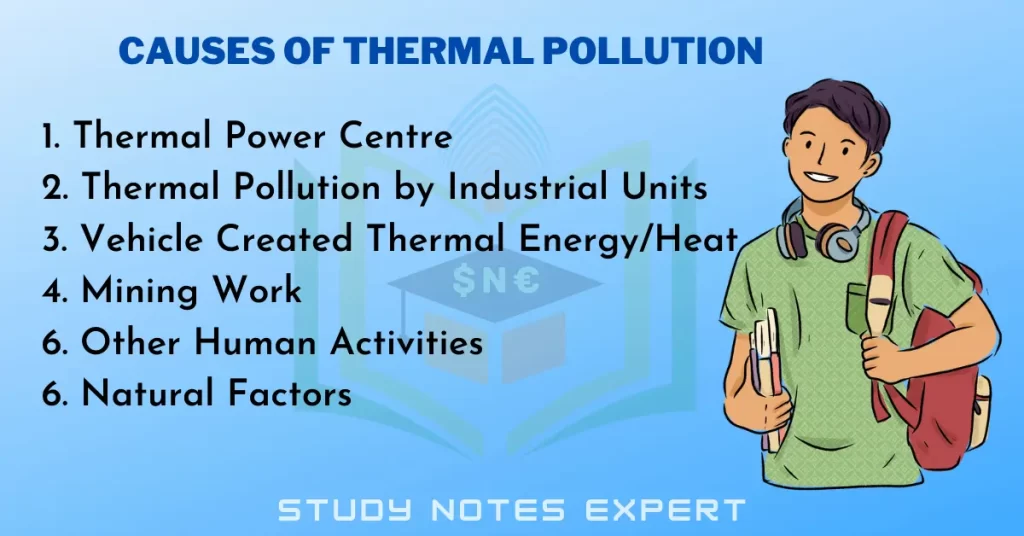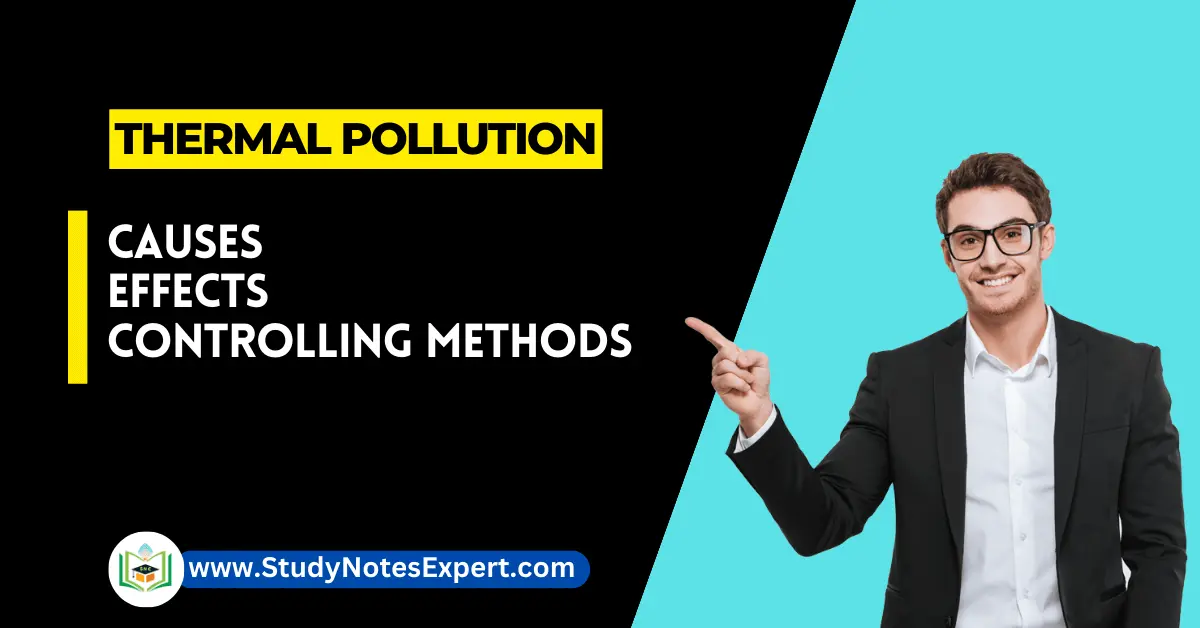Most thermal and electric power plants also discharge considerable quantities of hot effluents. This has resulted in thermal pollution of our water courses. Also, it is undesirable for several reasons. Warm water does not have the same oxygen-holding capacity as cold water. Therefore, fishes like black bags, trout etc., which require a minimum oxygen concentration of about 4 ppm, would either have to emigrate from the polluted area or die in large numbers. In this article, you will know the controlling methods of thermal pollution.
Official Causes of Thermal Pollution

Many factors are responsible for this pollution. Their description is as follows:
1. Thermal Power Centre
Today, man has created new energy sources, and a thermal power centre is one of them. 70% of the total coal found worldwide is used for this purpose. In the world, there are 5,000, and in India 16 centres where electricity is produced. In India, these centres use approximately 22,000 metric tonnes of coal daily. As a result, 5,20,000 pounds of sulphur dioxide, 4,50,000 pounds of nitrogen oxide, 11,300-pound carbon monoxide and 5,000-pound hydrocarbon; these pollutants and poisonous gases spread into the atmosphere.
One thermal powerhouse can increase the atmosphere’s temperature in an area of 10 km. Likewise, sulphur dioxide and coal ash also blow with the wind and fall on the land. So it covers not only the earth’s crust but, due to some heat, these elements become very hot. Moreover, the discharge of heated water from these powerhouses increases the temperature of that area and pollutes it.
2. Thermal Pollution by Industrial Units
Like thermal powerhouses, other industrial units also promote this pollution by releasing gases, smoke, ash, filth, and dirty and hot water. Constant machines and other activities also produce heat, increasing the nearby temperature.
- The smoke, ash, vapour, and fire through the chimney create a hot atmosphere. During summer, this situation becomes more dangerous and critical.
- The water released from industrial units is very hot. If thrown in the open, it scorches the upper layers of the earth and soil, rendering them useless. This water, by flowing into a pond, lake or river, make their water hot. So, their animals and other creatures suffer and sometimes die. Likewise, this hot water affects sea water also, and as a result, the temperature of seawater increases.
3. Vehicle Created Thermal Energy/Heat
There has been a constant increase in vehicles in every part of the world from the very start of the 20th century. The fuel used in such vehicles produces air pollution in the form of smoke and gases, and the contact of its tyres also produces heat. The air, polluted by smoke and poisonous gases, does not allow the heat to variate; as a result, the temperature of that area increases. It is often seen that where there is more transportation, due to heat, we feel exhausted and smothered with temperature is also higher than in other places.
4. Mining Work
Various metals and things for daily use are found through the mining process. Initially, this mining process affected the temperature of that area. But now, various kinds of chemical reactions are used. So there is a spread of dust in the nearby area, and the particles of that chemical also spread over the layer of earth and in the atmosphere and all these factors increase temperature. In modern times such a method is adopted by almost every country. Even in small areas, such methods are used on a large scale. For example, even in Sohna (Gurgaon) in Haryana, Khanak (Tosham) and for stone cutting in Shivalik regions, such methods are used.
6. Other Human Activities
Besides the above reasons, some human activities are causes of thermal pollution. Such as:
- In every country, army training and war practices are done. On the one hand, they cause destruction, and on the other hand, it spoils flora and funna. Moreover, due to their trespassing and activities, heat is produced.
- Air Conditioner uses oxygen and releases carbon dioxide, monoxide and chlorofluoro carbons. It increases the temperature. We can feel ourselves by standing near such equipment or machines that these internal cooling equipment produce so much heat.
- Due to development in scientific fields, nuclear power can be used in various forms. All activities increase the temperature of all land, water and air.
6. Natural Factors
Nature plays a major role in thermal pollution. Sun itself is a large circle of heat. The sun’s rays fall straight, and the temperature of that place is quite high. Their temperature may get so high that it becomes unbearable. Natural factors are the causes of thermal pollution. In the countries of the world whose climate is warm, the situation becomes more critical. In some parts of the world, the temperature rises to 60°C while human activities get affected by 40°C. This affects all places, water, land, agriculture, residential, industrial and commercial.
- Sometimes due to natural reasons, forests catch fire which is called forest fire. To control such fire is almost impossible and unsuccessful. Once the fire in the part of Mesopotamia was controlled in 6 years, the fire in Austria, which happened in October 2002, has not been controlled till today. So the temperature of that area is increasing continuously.
- The continuous thinning of the ozone layer allows more sun rays to reach the earth’s surface. This leads to a rise in the temperature of the earth.
- Due to volcanic eruptions, lava and other hot gases are released, which increase the temperature. Sometimes its effect reaches hundreds of km.
Unconditional Effects of Thermal Pollution
The effects of thermal pollution are very destructive. We can study its effects in the following points :
- The pollution results in high temperatures. It destroys the ecosystem’s equilibrium, which imbalances all kinds of equilibrium.
- Increased temperature creates drought problems, and animals, human beings, and vegetables suffer from various diseases, even causing death.
- Increase in the temperature of the atmosphere results in the depletion of the ozone layer; the weaker ozone layer will cause more ultraviolet rays to reach the earth. As a result, heat will increase, and the diseases like cancer will spread more and more. It is the effects of thermal pollution.
- The possibility of melting ice increases due to high temperatures in marine areas. Moreover, there is a danger of submerging the land in the sea. Various researchers claim that the sea level is rising to 2 to 3 cm yearly. If the process continues, then after 100 years, 1/4 of the world will be submerged in the sea.
- In high temperatures, flora and fauna may not survive. In some parts, due to improper harvest cycles and lack of plans and vegetable life will be in danger. It is the effects of thermal pollution.
- High temperatures will dry up the water sources or speed up the process. Along with this whole world will be affected by acid rain, and its consequences will be disastrous.
- Thermal Power Houses enhance the temperature and produce noise pollution. Thus increasing our problems.
Certified Controlling Methods of Thermal Pollution
The following are the controlling methods of thermal pollution:
1. Cooling Ponds
Water from condensers is stored in ponds where natural evaporation cools the water, which can then be recirculated or discharged into nearby water bodies.
2. Spray Ponds
The water from condensers is received in spray ponds. Here the water is sprayed through nozzles where fine droplets are formed. The spray ponds are the controlling methods of thermal pollution. The heat from these fine droplets is dissipated into the atmosphere.
3. Cooling Towers
(i) Wet Cooling Tower
Hot water is sprayed over the baffles. Cool air entering from the sides removes the heat and cools the water. This cool water can be recycled or discharged. A large amount of water is lost through evaporation. In the vicinity of the wet cooling tower, extensive fog is formed, which is not good for the environment and causes damage to vegetation.
(ii) Dry Cooling Tower
The heated water flows in a system of pipes. Air is passed over these hot pipes with fans. This method has no water loss, but a dry cooling tower’s installation and operation costs are many times higher than a wet cooling tower.

